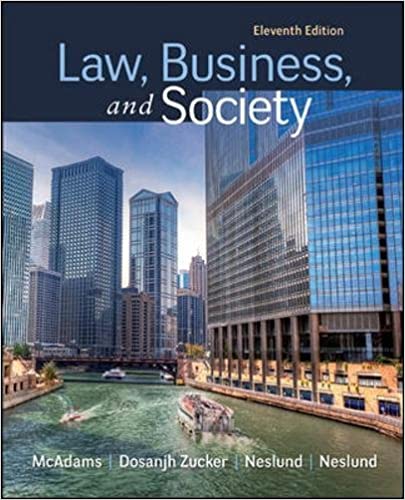
Law, Business and Society 11th Edition by Tony McAdams
Edition 11ISBN: 978-0078023866
Law, Business and Society 11th Edition by Tony McAdams
Edition 11ISBN: 978-0078023866 Exercise 23
Four former college athletes representing a class of more than 20,000 former college athletes sued the National Collegiate Athletic Association (NCAA) seeking to change NCAA limits on the amount of aid that student athletes can be granted. Under long-time NCAA rules, so-called full-ride scholarships were limited to tuition, books, room, and board. The athletes claimed they were denied approximately $2,500 annually because their universities were not allowed, under NCAA rules, to pay the "full cost of attendance," a package that would include money for insurance, laundry, school supplies, telephone, travel, and so on, in addition to the "full ride."
The class action involved all those playing "major college football" (what was Division l-A and is now the Football Bowl Subdivision) and "major college basketball" (16 top conferences) since 2002. Total damages were estimated at several hundred million dollars. The lawsuit claimed that the NCAA rules constituted a "contract, combination, and conspiracy to fix the amount of financial assistance available to student athletes," thus restraining trade in violation of section 1 of the Sherman Antitrust Act (explained below).
The case was settled in 2008 when the NCAA agreed, among other things, to set aside $10 million over three years to be paid to qualified class members (estimated at 12,000) to reimburse them for bona fide, future educational expenses. Athletes could apply for up to $2,500 per year for three years. The settlement also offers athletes easier access to an existing NCAA pool of $218 million over the years 2008 to 2013 for legitimate educational expenses beyond the "full ride."
As you read this chapter, think about whether the NCAA limit on scholarship funds was, in fact, a violation of antitrust law, but for our immediate purposes, think about the athletes' complaint as a matter of right and wrong; of fairness. [For more on this case, see www.studentathleteclassaction.com ]
Should college athletes be free to "sell" their services to the highest bidder among America's colleges and universities Explain.
The class action involved all those playing "major college football" (what was Division l-A and is now the Football Bowl Subdivision) and "major college basketball" (16 top conferences) since 2002. Total damages were estimated at several hundred million dollars. The lawsuit claimed that the NCAA rules constituted a "contract, combination, and conspiracy to fix the amount of financial assistance available to student athletes," thus restraining trade in violation of section 1 of the Sherman Antitrust Act (explained below).
The case was settled in 2008 when the NCAA agreed, among other things, to set aside $10 million over three years to be paid to qualified class members (estimated at 12,000) to reimburse them for bona fide, future educational expenses. Athletes could apply for up to $2,500 per year for three years. The settlement also offers athletes easier access to an existing NCAA pool of $218 million over the years 2008 to 2013 for legitimate educational expenses beyond the "full ride."
As you read this chapter, think about whether the NCAA limit on scholarship funds was, in fact, a violation of antitrust law, but for our immediate purposes, think about the athletes' complaint as a matter of right and wrong; of fairness. [For more on this case, see www.studentathleteclassaction.com ]
Should college athletes be free to "sell" their services to the highest bidder among America's colleges and universities Explain.
Explanation
Several researchers found that college a...
Law, Business and Society 11th Edition by Tony McAdams
Why don’t you like this exercise?
Other Minimum 8 character and maximum 255 character
Character 255


